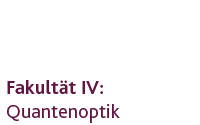European Integrated Project Qubit Applications
The University of Siegen leads the Subproject Quantum Simulation and Control
Objectives:
In order to physically implement universal quantum computation and apply it to interesting problems, quantum gates have to be executed with demandingly high precision and need to be applied to a large numbers of qubits. Recently it has been shown that the simulation of one quantum system by means of observing the dynamics of another suitably tailored quantum system can be far less demanding than universal quantum computation in these respects. Another way to cope with the daunting requirements of universal QC is the development of practical schemes for the better control of the quantum evolution of individual building blocks for quantum computation, that is, error correction, characterization and subsequent control of decoherence, and of robust and optimized quantum gates.
1. Simulation
A system of pairwise coupled spins described by a Heisenberg model or a variant thereof is particularly useful for quantum simulations. Such models serve as a starting point for numerous theoretical investigations in various branches of Physics, and in particular in Condensed-Matter Physics where collective effects, like [anti-]ferromagnetism and super conductivity, are investigated. Recently, with the advent of quantum information science, such systems have been investigated in a new light taking also into consideration the interplay between entanglement of individual quantum systems and global properties of the system. The simulation of the quantum evolution of a large number of spins that could shed more light on the appearance of these phenomena is not tractable on classical computers.
Exploring suitable systems with known and well controlled spin Hamiltonians, in addition, will allow for the investigation of new schemes for generation and propagation of entanglement: Quantum states can be created and transferred in quantum many body systems (and in particular using mutually coupled spins) without the need for detailed local control of qubits. This in turn will pave the way towards short distance quantum communication.
2. Control
It is an important and essential task to develop schemes and tools that provide significant improvements of the potential, the robustness, and the speed of experimental realizations of quantum gates. Optimal Control Theory is generally applicable and, therefore, is an ideal tool to accomplish this challenging task. Specifically, the development and the experimental realization of time-optimal, relaxation-optimized, and robust implementations of quantum gates and quantum algorithms using spin-spin coupled systems will be targeted. In turn, the results attained using control theory will be used for investigating quantum simulations, and in particular quantum phase transitions with spin chains.
In order to gain better control over the execution of quantum algorithms it is furthermore necessary to develop practical schemes for quantum error correction and to reliably identify sources of decoherence in large qubit registers and find ways to remedy them. These investigations will be carried out employing different types of spin many-body systems that will serve as well controlled prototype systems and will allow for the exploration of quantum simulations and optimal control:
- Crystals doped with rare-earth-ions: Lund Institute of Technology, Sweden
- Ultrapure diamond with nitrogen vacancy defects: University of Stuttgart, Germany
- Liquid-state nuclear magnetic resonance in combination with specifically synthesized molecules that comprise a tailored spin-topology: Technical University Munich, Germany
- A novel type of ion trap that provides pairwise spin-spin couplings between individual ions: University of Siegen, Germany
All of these physical systems have clearly demonstrated their potential for quantum information processing. Despite their obvious differences, these systems can all be described in pseudo-spin terms by similar effective Hamiltonians. Not only the mathematical description of these systems is similar, also the physical coherent manipulation of qubits of systems 2, 3, and 4 is achieved by similar methods using rf and/or microwave radiation.
Partners working on theoretical aspects of Quantum Simulation and Control include:
Imperial
College of Science, Technology and Medicine, UK
Macquarie
University, Australia
Slovak Academy of
Sciences, Slovakia
University of
Barcelona, Spain
University of Hertfordshire, UK
University of
Queensland, Australia
